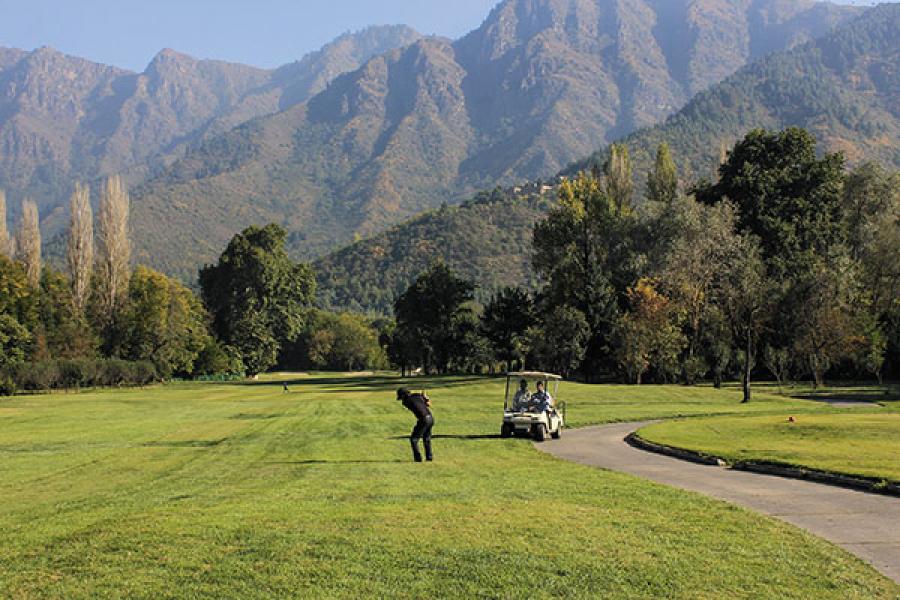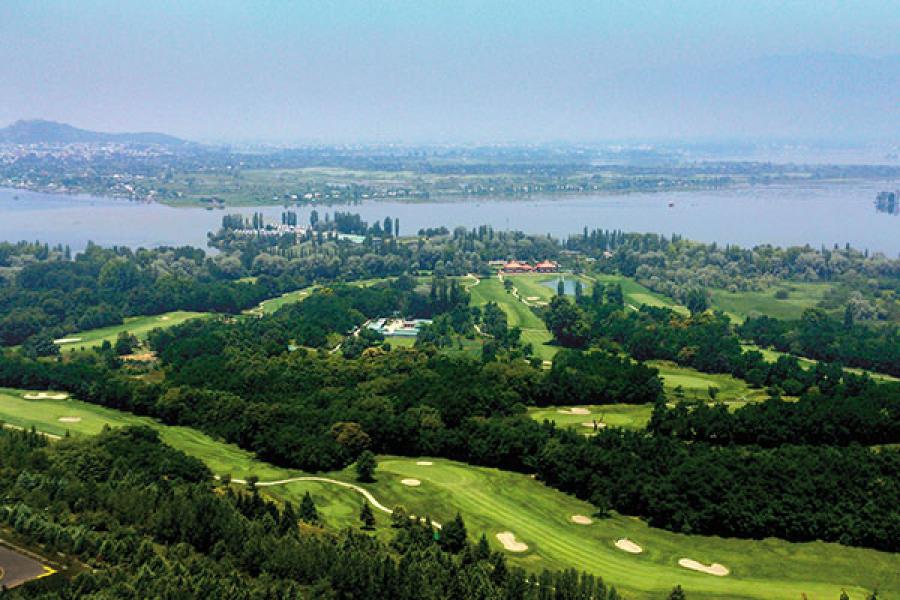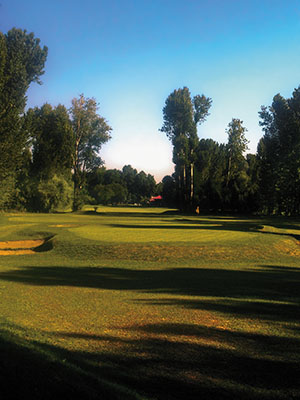
Swing State: Golf in the Kashmir Valley
A driving golf holiday to the Valley can get pretty action-packed
If you’re driving about in Kashmir on a golf vacation, then you’ve got to be pretty careful who you ask for directions. I mean, there’re some pretty stern folks out there, and golf isn’t top of their mind. You don’t just pull up in a flashy SUV and ask breathlessly, “Sir, am I on the right path for the Royal Springs Golf Course?” That is when, muttering under their breath, they consider telling you, no, you’re obviously not on the right path. And that you’re living on the trivial fringes of life while ignoring the things that really ought to matter. And that, as far as they’re concerned, the golf course could go to seed. And, come to think of it, so could you. But they just stifle all that, and give you a look bordering on pitiful disdain and move along.
But you can’t blame them, there’s plenty going on in the Valley, and I’m not talking about who won the monthly medal round at the Royal Springs Golf Course in Srinagar or, for that matter, whether the greens have been manicured this week. For the Kashmiri on the street, golf courses in the state are an inexplicable extravagance. If you’re a passionate golfer looking for golf courses in Kashmir—and this writer highly recommends that you do—then you’ll just have to find them yourself.
Besides, in true Indian tradition, what kind of self-respecting pilgrimage would it be if it didn’t involve rigour and its share of travails? The search is crucial to the experience. My own crusade began in a tony enclave of Gurgaon, where I parked my trusty Ambassador—a gorgeous artefact whose considerable merits do not include long-distance hauls—and borrowed the baby in Audi’s SUV line-up, the Q3.
May I digress here to recommend, if you decide to drive to Kashmir, to exchange your fuel-efficient eco-friendly ride for one of those big SUVs? While the highway is great most of the way, it certainly shouldn’t be taken by anyone who hasn’t finished paying the EMIs on his car. On the other hand, SUVs—so big and unwieldy in the city—really come into their own on this stretch, crunching miles at a prodigious rate while you listen to delicate etudes ensconced in the cabin.
As it turned out, my photographer-friend, who had been salivating at the prospect of a road trip, turned pale at the mention of Kashmir, and conveniently developed a life-threatening flu the day before our departure. And that was, in retrospect, the moment of folly when, in a state of delusion and ignorance, I decided to go it alone.
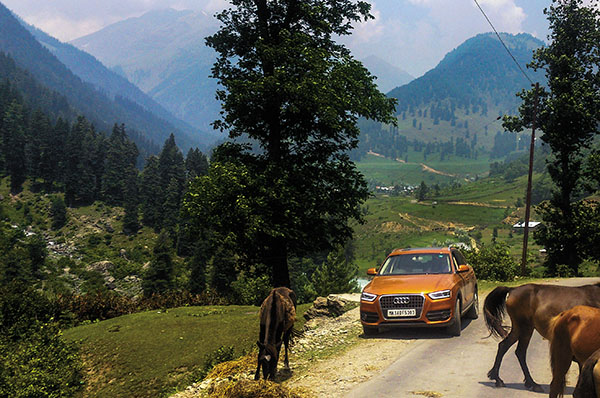
An SUV, so big and unwieldy in the city, is a must for a road trip to Kashmir. It comes into its own on the stretch, crunching miles at a prodigious rate
Driving long distances alone can be a strangely levitating experience. It’s not the same as taking a one-way trip to Mars, but you know that you’re lonely when you start voicing existential questions to yourself. Eventually you start giving lifts to strangers but not so early, especially when you’re driving on NH1 through the Punjab hinterland.
Punjab is a bit like Texas, what with its love of guns and alcohol, and stretch limos. And for all the green fields, there’s not a fresh vegetable to be found in any of the dhabas on NH1A. The state bird is tandoori chicken or, alternatively, tandoori chicken in gravy. Parts of this state abut the Line of Control, and the frontierism is hard to miss.
Eventually, after crossing Chandigarh and Pathankot, you find yourself on the home stretch to Jammu. A note here about the City of Temples: Do not mention you’re going up to Kashmir to a local, unless you want to listen to gripes about how they got a raw deal, and how the government promotes Kashmir while Jammu is left to fend for itself. And do not, under any circumstances, think aloud what it is that can be promoted in this hot and dusty plains town.
Camping for the night at an obscure hamlet called Sanasar, about 20 km from Patnitop, I have a eureka moment, when I discover that the meadow has remnants of greens and tees.
Apparently, a bureaucrat decided to build a golf course here a decade ago. Now, presumably with him or her posted out, the course has been claimed back by the meadow and sheep and horses graze here while children play cricket on the fairways. It’s a shame, because the setting is tremendous and, on a clear day, the snow-clad peaks are within 5-iron distance.
‘Kashmir Valley’ is one of those terms defined by its profligate use in the media. It’s only after you hit the plains after the Jawahar Tunnel that you look around at the peaks and realise that you are, in fact, in a valley.
It isn’t particularly big—it’s only 135 km long and 32 km wide, wedged between the Karakoram and Pir Panjal ranges—and really small, considering all the trouble going on inside it. And that’s when it hits you: This isn’t a place to be faffing around alone in an orange SUV with a golf bag in the back.
You wouldn’t believe it though if you saw the sheer number of tourists milling about on the boulevard in Srinagar. Every 10 minutes, it seems, a bus comes to a screeching halt and the doors open to release loud, boisterous children and their fawning parents. If you choose to stay in a houseboat in Srinagar (as you must), consider hiring one in the much quieter and serene Nagin Lake.
There’s a lot to do around town, although it’s difficult not to get stampeded by crowds in the summer unless you wake up early and head out. For a panoramic view, head to the Pari Mahal, the ruins of a Mughal observatory halfway up the Zabarwan mountains. The six-terraced 17th century structure perched on a hilltop overlooks the RSGC and, beyond that, the Dal.

Stretched over 6,445 m and carved out of a deciduous forest and fruit orchards, the elaborate 300-acre layout, the course sits next to the erstwhile palace of the Maharaja (now the Lalit Hotel). The ruins of Pari Mahal overlook the course and are best seen while walking the 14th fairway. Though more than anywhere else in Kashmir, the number of golfers is still pretty thin, and you can easily get a walk-in tee time.
Most Kashmiris believe that there’s only one golfer in the state and, since he happens to be the former chief minister, that he created these golf courses to pursue his own passion. While those charges may stick when it comes to the lovely RSGC, they certainly don’t hold for the historic Kashmir Golf Club, also in Srinagar. With pictures of golfers in plus-fours, berets, and swinging hickory-shafted clubs on the clubhouse walls, the KGC is a living relic of British rule in the late-19th century. And it isn’t the only one either: You can just imagine the scene in 1890 when a dewy-eyed Colonel Neville Chamberlain, moping for the links in his beloved Blighty, discovered Gulmarg’s Alpinesque meadows, natural rolling landscape, and very English climes. He must have shouted ‘Fore!’ before going on to lay six rudimentary holes.
The Gulmarg GC is hard to miss: It lies centrestage in the main meadow (which is essentially the town) with the 4 km loop of road going around it. There’s nothing better than watching tourists and ponies breathing down each other’s neck, while you saunter about the most picturesque patch in town.
Of course, that also means you’ll have a gallery: I can’t remember the number of times my follow-through was compared to Sachin Tendulkar’s six (‘over the bowler’s head!’). At 6,505 m (including a 630 mt par-5), the Gulmarg GC is one of the longest, and physically challenging to get around. And true to its links-style inspiration, the rough, much like gorse, is inextricable. But playing at this centurion, surrounded by snow-capped peaks, is, at least for me, the definitive experience in Gulmarg.
Of course, those who don’t agree can make a beeline for the gondola, which will whisk them away to the top of Mount Affarwat ridge, where they can hurtle down the glacier on rudimentary wooden contraptions. On the way down from Gulmarg, there’s an interesting side-trip from Tanmarg to Drung. An unremarkable streamside picnic spot at first glance, it rewards you with the ruins of an ancient temple after a bit of a climb. Believers are of the opinion that the history of the temple can be traced back to the Mahabharata.
Back in Srinagar, I first overhear a mention of the Lidder Valley Golf Club in Pahalgam at a public bar. No, that’s no oxymoron: There is such a place in the capital of Kashmir where the good stuff is still tippled, albeit behind closed doors and oversized wooden furniture. At the unmarked, unadvertised Highland bar, behind the iconic Broadway theatre, I hear a couple of cab drivers laughing about the tenacious crows—did I hear that right?—on the Pahalgam Golf Course.
Turns out, they weren’t exaggerating. There are ravens at this golfing Valhalla, which make a Stuka-like dive for your golf ball the moment it lands in the fairway and make off with it, presumably to a nest where they wait for it to hatch. I’ve never been a fan of speed golf, but I’ve never sprinted so hard after hitting a shot as I did at this course—and I still lost half a dozen golf balls to these avian bombers.
The course itself is, for lack of a better word, magnificent. Considering the dearth of championship golf courses in India, it’s no small tragedy that a course of this calibre, with a natural setting that’s comparable to any of the top Alpine courses in Europe, should see so few golfers tee it up. The fairways have serious changes in elevation, coursing along undulating hillocks and around a smattering of water bodies, all within a pristine forested area surrounded by peaks of the middle Himalayas. Which may be just as well because the course is a devil in disguise: Extremely long, with glassy greens as quick as you’re likely to find anywhere, and fraught with all sorts of natural and man-made perils making a round impossibly challenging for anyone but the expert player. The highlight is the 200 yard+ par-3 13 hole with a fairway about as wide as your SUV, possibly the narrowest in the country.
After my round, the caddies insist I join them for a meal in a small room next to the first fairway. Gasping for breath in the haze of beedi smoke, I tell them about my plan to drive up to Baramulla to play at the Army GC there. “Not a good idea, there’s been some trouble there just yesterday,” one says. “Why, what’s the worst that could happen?” I ask. “You’re obviously an outsider, you could get abducted at the very least,” he says nonchalantly.
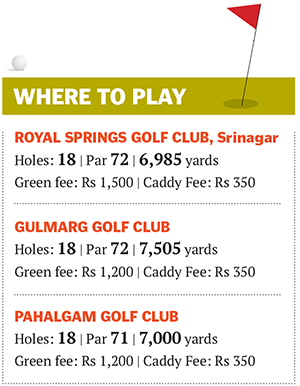
Confronted with the unenviable proposition of being confined to my hotel room indefinitely, and further golfing plans well and truly stymied, I make a hasty departure, covering the 1,000-odd km from Pahalgam to Delhi in a tortuously long drive. In retrospect, there couldn’t have been a more appropriate exit line for my trip. Sometimes, when you’re travelling, you stop at a place and wish you had more lifetimes, perhaps to settle down in one of these places, get to know people better and maybe make a life out of it. Kashmir isn’t one of those places: You’ll join the throngs of tourists who descend on it every year, and stay until the next episode of violence. When that at happens, it’s time to leave.
Disclaimer: Audi provided a Q3 to the author of this piece for the duration of his trip in Jammu and Kashmir
(This story appears in the 15 November, 2013 issue of Forbes India. To visit our Archives, click here.)
-
 Wonderjam
WonderjamMeraj, your opening para was hilarious and paints the pervasive idea about what life is like in the subcontinent, and not just in Kashmir. :)
on Nov 15, 2013-
 Meraj Shah
Meraj ShahGlad it got a chuckle out of you wonderjam! You\'ll be surprised though, at the pace at which things are changing, at least as far as golf is concerned.
on Nov 15, 2013
-
-
 Suresh
SureshA delightful article on Golf in Kashmir. The state bird is Tandoori Chicken.LOL. The state drink could be a bottle of Desi.(santra or narangi).Well, these stern looking people may get a chance to rule the state in next few years? The Golf courses will have a hard time to survive, in their regime. The people of Jammu could be right in their grievance. The Govt. both at Center and JK do not want to do so.Who said hot and dusty plain towns cannot be developed. What was Gurgaon once upon a time..In the 50s not even water was available.You talked about Texas..... there are lot of towns which were dusty and sleepy just a couple of decades ago in this big big state but they have shown maximum growth (Time magazine report) now What is lacking is the will of the Govt. at the state and the Centre.
on Nov 13, 2013 -
 Suresh
SureshState bird is Tandori chicken LOL Well the state drink could be a bottle of desi(narangi or santra). May be these stern looking people will govern the state in coming years. (It is only matter of years)The golf course is bound to disappear. The people of Jammu are right in their grievance. Who says sleepy and dusty towns cannot be developed, if there is a will, even the dust can be turned into a gold or a tourist spot. You have spoken about Texas..... there were so many dusty towns which have been turned into good towns.
on Nov 13, 2013
